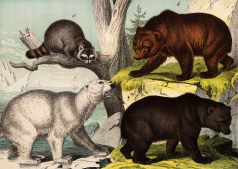The Role of Human Activity in Shaping Global Species Distribution Dynamics
Understanding how human activity influences global species distribution is crucial for conservation efforts and biodiversity management. As our planet continues to face unprecedented changes due to urbanization, climate change, and habitat destruction, it is essential to explore the dynamics that drive these shifts in species distribution.
What is Global Species Distribution?
Global species distribution refers to the way in which different species are spread across various geographic areas around the world. This distribution can be influenced by natural factors such as climate, topography, and ecosystems, but increasingly, human activities have become a significant driver of change. Changes in land use for agriculture, urban development, and infrastructure can lead to habitat fragmentation and loss, which directly affects where species can thrive.

Human Activities Impacting Species Distribution
Several human activities are known to impact global species distribution significantly. Deforestation for timber or agriculture reduces habitats available for native flora and fauna. Pollution from industrial processes contaminates ecosystems while climate change alters temperature and rainfall patterns that many species depend on. Additionally, the introduction of invasive species by humans can outcompete native organisms for resources, leading to declines or extinctions.
Urbanization: A Double-Edged Sword
Urbanization is one of the most profound ways humans influence species distribution. While cities create environments that exclude certain wildlife populations due to pollution and noise, they also provide unexpected opportunities for others—such as opportunistic bird species or plants adapted to disturbed soils. The challenge lies in balancing urban growth with sustainable practices that protect biodiversity while meeting human needs.
Conservation Efforts Amidst Change
In response to these challenges posed by human activities on global species distribution dynamics, numerous conservation efforts have been initiated worldwide. Protected areas like national parks serve as critical refuges for many endangered species while restoring degraded habitats through reforestation projects helps combat some effects of deforestation. Community-led conservation initiatives also play a vital role by involving local populations in protecting their natural surroundings—often leading to innovative solutions tailored specifically for regional challenges.
The Future: Collaborative Approaches Needed
Looking ahead, addressing the impacts of human activity on global species distribution will require collaborative approaches involving governments, non-profits, scientists, and communities alike. Collectively creating policies that prioritize ecological integrity alongside development goals will foster resilience within ecosystems globally while ensuring that future generations inherit a thriving planet rich with biodiversity.
In conclusion, understanding how our actions shape global species distribution dynamics is fundamental not just for conserving wildlife but also maintaining healthy ecosystems upon which humanity depends. By recognizing our responsibilities towards nature and actively engaging in sustainable practices we can help mitigate adverse effects on biodiversity.
This text was generated using a large language model, and select text has been reviewed and moderated for purposes such as readability.


